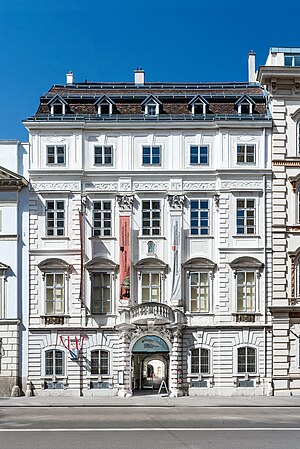Esperanto Museum
| Data | |
|---|---|
| place | Vienna |
| Art | |
| opening | 1927 |
| operator | |
| Website | |
The Esperanto Museum of the Austrian National Library with the collection for planned languages was founded as an association by Hofrat Hugo Steiner in 1927 and set up at the Austrian National Library in Vienna in 1928 .
More than 80 years of continuous collecting resulted in the world's largest specialist library for around 500 planned languages .
exhibition
The Esperanto Museum of the Austrian National Library has an exhibition area of 80 m² and is considered the most important of its kind in the world. Multimedia presentations convey the more than one hundred year history of Esperanto. Other planned languages, such as the mystical Lingua Ignota by Hildegard von Bingen or Klingon from the television series Star Trek, can also be accessed via listening stations .
The collection is in the possession of several important pre-eminent and bequests, such as that of Eugen Wüster , the founder of international terminology work, or that of the Catalan - Portuguese writer Manuel de Seabra .
The collection for planned languages of the Austrian National Library is also the world's largest specialist library for interlinguistics and documents around 500 different planned languages - including Volapük , Ido , Interlingua and Esperanto - in 35,000 volumes, 3,700 magazine titles , 3,500 museum objects, 10,000 autographs and manuscripts , 22,000 photos and photo negatives , 1,500 posters and 40,000 pamphlets .
In a large-scale, multi-year digitization project, it is planned to put a substantial part of the library online. In 2007 the first tranche was scanned. The documents can be called up on the website (see there under "Scanned books online"). To date, more than 13,000 photos are accessible online via the Austria Image Archive.
The location of the Esperanto Museum was originally the Hofburg . In 2005, the company moved to the baroque Palais Mollard-Clary at Herrengasse 9 in downtown Vienna.
See also
Web links
- Esperanto Museum
- Collection for planned languages
- Esperanto in the picture archive Austria
- Scanned books online
- Scanned magazines online
Individual evidence
- ↑ More details on Hugo Steiner's biography under Hubert Bergmann: Biography of the Month August 2019 - Hugo Steiner (1878–1969) - a life for Esperanto. Austrian Academy of Sciences (ÖAW), July 2019, accessed on August 5, 2020 .
Coordinates: 48 ° 12 ′ 33.5 ″ N , 16 ° 21 ′ 55 ″ E
